NOTE:
This article is dynamic in that it will change over time as new or
different information is found.
First published 3NOV06 - current revision 30AUG2008
It’s depressing what little there is to say about the following chapter in 3D history. Not ancient history, but there was little effort at the time to document things.
We start with MGM’s Frederick (Fred) C. Quimby (1916-1965) acquiring some gag/demo footage shot by Jacob F. Leventhal (?-1953) and John A. Norling (1896-1957).
Quimby handed the footage over to Pete Smith (1892-1979) to shape into one of his well-known comedic shorts.
The result was the 8+ minute AUDIOSCOPIKS, which opened nationally, according to Smith himself, 11JAN1936 (though it opened on 8JAN36 in LA).
It was apparently a smash.
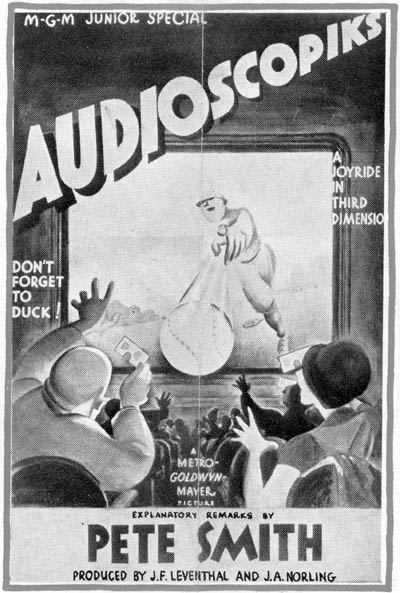
A B&W; image of the original 1 sheet poster.
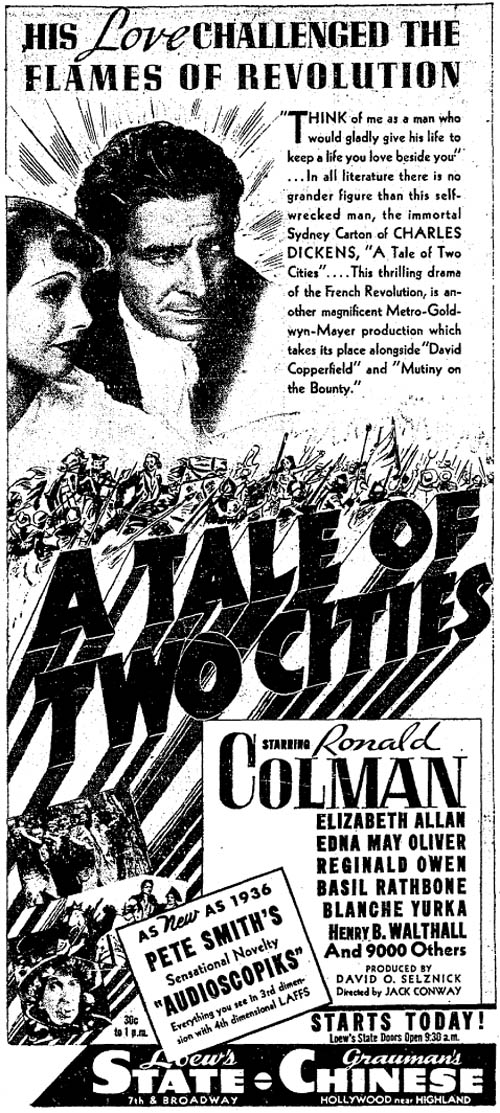
Opening day ad in LA, 8JAN1936.
We don’t know if MGM ordered more footage to be shot, or Leventhal and Norling already had it, but sometime in 1937, it was decided to make a sequel.
THE NEW AUDIOSCOPIKS opened, again per Smith, 15JAN1938.
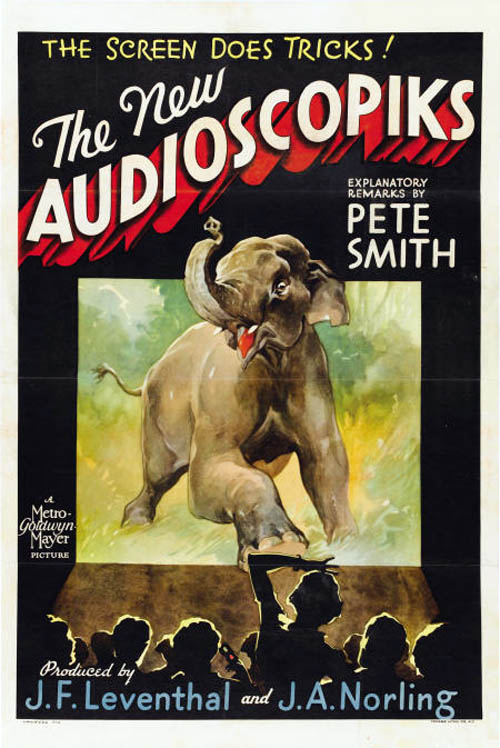
Finally, MGM built its own 3D camera, and shot Pete Smith’s own footage, THIRD DIMENSIONAL MURDER. This was released 1MAR1941.
Leventhal’s previous 3D venture was for the PLASTIGRAMS/STEREOSCOPIKS shorts 1924-25.
Leventhal most likely met up with John Norling (also from NYC) at the J. R. Bray Studios where Dave Fleischer (1894-1979) was doing the OUT OF THE INKWELL series which apparently involved both of the boys at some point. Norling had directed two shorts for Bray, in 1922 and 1923.
Sometime by 1935 they shot 3D gag footage, not unlike the STEREOSCOPIKS shorts. It was reported the filming took place in a small “studio” on 55th Street, NYC. That studio was Norling's office address (245 West 55th Street) and it was and still is the Du-Art Film Laboratory.
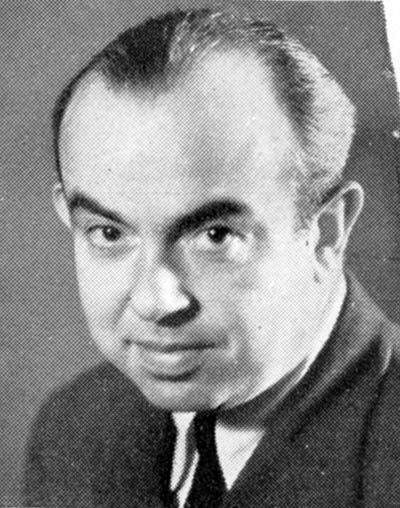 Jacob
F. Leventhall, ca. 1935
Jacob
F. Leventhall, ca. 1935
John Norling, ca. 1935 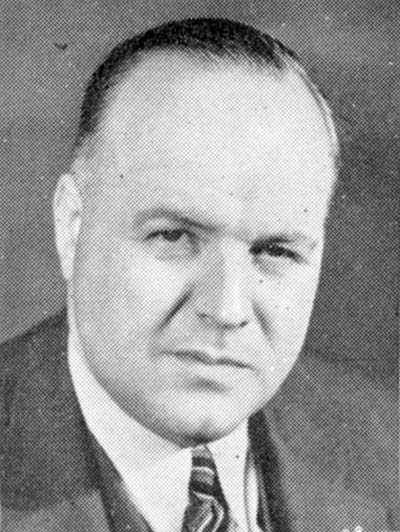
Norling later became a 3D specialist but I have not found any professional 3D achievements prior to this time. In his own writings, he refers to working on 3D camera ideas at least as far back as 1931. Otherwise, Norling was in a partnership with a fellow named Loucks (company Loucks & Norling Studios), which continued until ca. 1951.
We are fortunate that the camera used to shoot the footage is seen in the beginning minutes of AUDIOSCOPIKS.
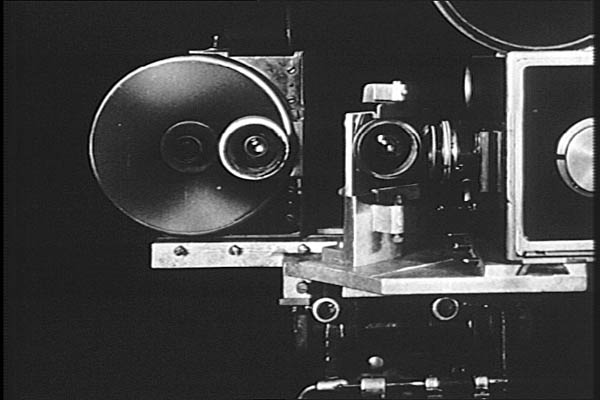
Two B&H 35mm cameras, at right angles, with a mirror in front of one lens. I have yet to find a patent for this camera arrangement, nor one like it. This design was subsequently used in 1953 by Warner Bros., 20th, MGM, and RKO. The first two received patents.
Convergence was not evident in the program.
There is no known, original print, so we can’t say for certain what lab did the two-color printing.
An original print of Smith’s third short, THIRD DIMENSIONAL MURDER (TDM), does exist and it was produced by Technicolor. The colors for the anaglyph were uniquely cyan/magenta. In other words, minus yellow. Easy for the lab to produce, though not as good as cyan/red.
Technicolor was able to produce three-color from about 1932 on. But 3D, using the cyan/magenta, two-color, would have been somewhat “cost effective” for a short, being two color versus three.
It seems likely MGM had the color work done at Technicolor for all three shorts.
The big hang-up for the 3D shorts of the 20’s was the glasses issue. MGM solved that by having the theaters buy the glasses at $3.25 per thousand (about 3½¢ each) from the MGM exchanges (local offices). The pressbook stated the glasses were unprinted, and suggested hooking up with local optometrists, etc., and have them pay for the glasses featuring their advertisement. Apparently this idea worked as can be seen below.
By the way, 3½¢ is about 50¢ today!
As it can take maybe two weeks to make additional glasses, MGM had to have gambled a bit for the first release. They wouldn’t want to be stuck with tons of glasses if the show tanked.
It didn’t.
It was reported MGM had 3,000,000 glasses made for AUDIOSCOPIKS alone.
The glasses were made by the then-leading manufacturer of 3D glasses (from the 20’s), Freedman Cut-Outs, Inc.

Original AUDIOSCOPIKS glasses still attached to part of a scrap book (dated Jan '36).
The writing, by a woman from Apollo, PA (next to Vandergrift) says:
"I received these glass at the Manos when I saw "Rose Marie" -- MacDonald Nelson Eddie"
The Manos theater was in Vandergrift. The green lens has faded ("red right").
One of AUDIOSCOPIKS’ claims was that it was the first kereostopic, er, third dimensional film with sound.
While it did have narration, music, sound effects, and playback for a singer, it was not a sound movie, per se. A bit of a stretch, but illustrates their desire to be “first” about something.
And for the record, AUDIOSCOPIKS is the first 3D film to have been nominated for an Academy Award.
The third title was fully scripted (Jerry Hoffman), and shot at MGM's studios (DP Walter Lundin), taking advantage of existing sets, props, and costumes. There’s a witch that positively came from THE WIZARD OF OZ (1939). They came up with their own Frankenstein monster, which might have been a licensing problem with Universal in later years.
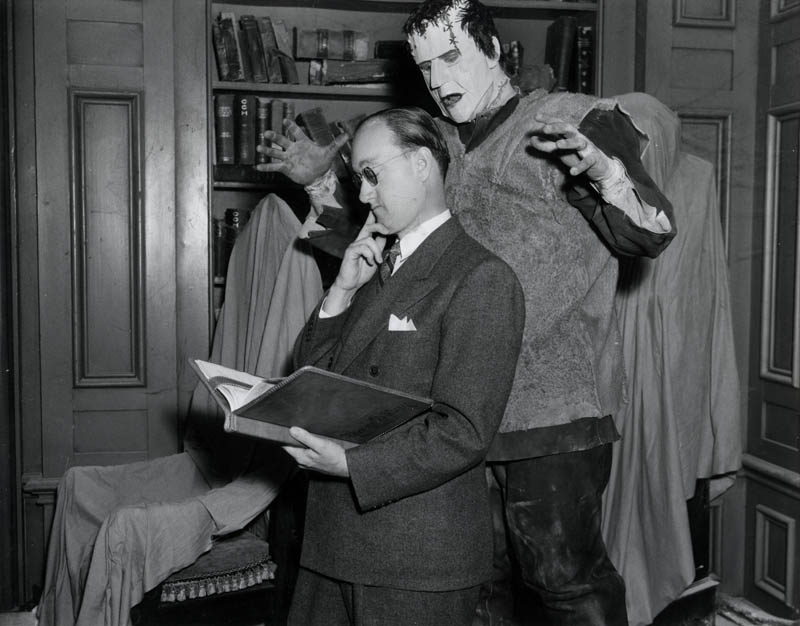
Gag shot with Pete Smith contemplating the script while
Frankenstein's monster (Ed Payson) contemplates him.
Director George Sidney was a rapidly rising star at MGM (his first feature also in 1941), and while there’s little evidence of genius in TDM, it was professionally done. He did KISS ME KATE 12 years later, his 2nd and last 3D project.
Neither Leventhal nor Norling were involved in the third short. Norling produced three short 3D films during 1939-1940. One involved Leventhal. But one or the other should have been available, would MGM have been interested.
Likely Smith, Quimby and/or others felt the quality of the Leventhal/Norling productions to be lacking. So they directed the studio laboratory head John M. Nickolaus (1881-1963) to build their own 3D camera.
Interesting, considering World War II was reviving up.
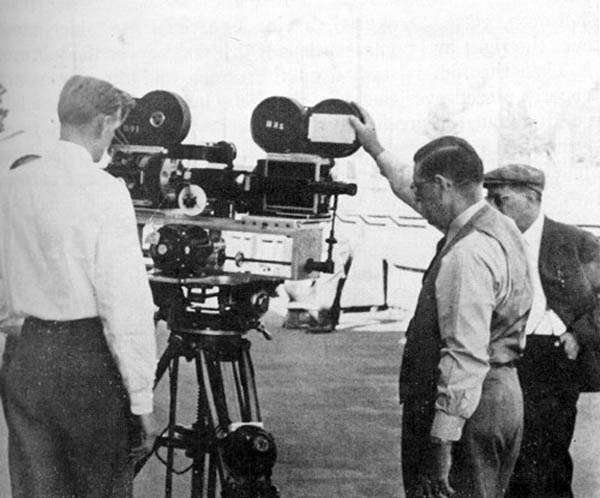
They aimed two B&H 35mm cameras face-to-face, with mirrors (perhaps prisms) for both lenses. This design was later used by Stereo Techniques in the UK (’50), Natural Vision (’51), Paramount, and Stereo-Cine, to name a few.
The flaw with all three shorts was the lack of understanding of convergence. Ignorance may be bliss, but hard on the eyes.
Norling apparently learned about convergence by 1940 for his NEW DIMENSIONS, produced for the Chrysler Corporation for exhibition at the 1939-40 World’s Fair.
He actually produced first a B&W version for the 4MAY1939 opening, titled IN TUNE WITH TOMORROW, then a color version (NEW DIMENSIONS) for the 1940 “season.” Two films, subjects of another chapter.
As of this date (NOV06), ITWT is a lost film. But most of NEW DIMENSIONS exists. And Norling used convergence and used it well.
But Smith’s THIRD DIMENSIONAL MURDER didn’t know from convergence, meaning they literally copied the way Leventhal/Norling shot their footage back in ‘36.
Had the three shorts been corrected even in post production, they would have been MUCH easier on the eyes. They didn’t know.
But all three did good business. Some theaters booked the shorts more than once.
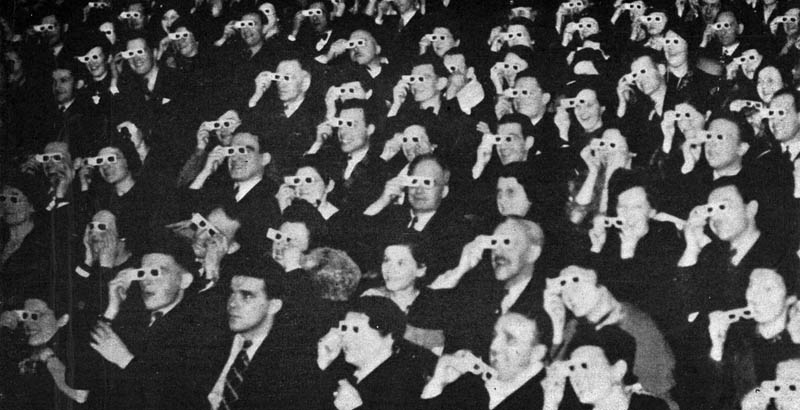
An obviously thrilled audience watching either
AUDIOSCOPIX or THE NEW AUDIOSCOPIKS.
Since 1941, these shorts have often been referred to in articles about 3D as the “first.” Not true, but they were the most widely seen 3D films. And if one were to be able to get the numbers, I feel if you could find the number of people seeing one or more of the three shorts, compared with the number of people going to movies—and did the same for people seeing 3D films in 1953—these three films would likely still have the “most seen 3D” record. The main reason for this theory is that the anaglyph shorts played in virtually any theater, anywhere. The 3D films of 1953 required polarized projection which was comparatively a small number of theaters.
- - - - - - - - - - -
My thanks for help from Jeff Joseph in tracking down details.